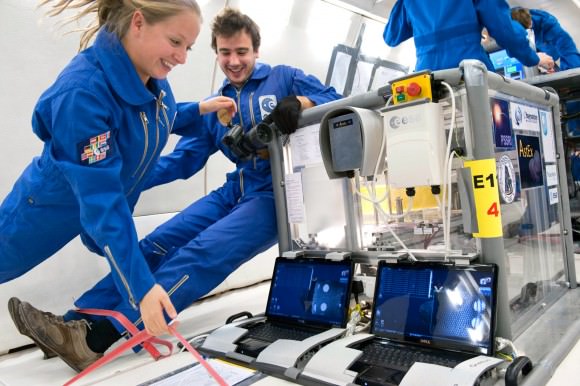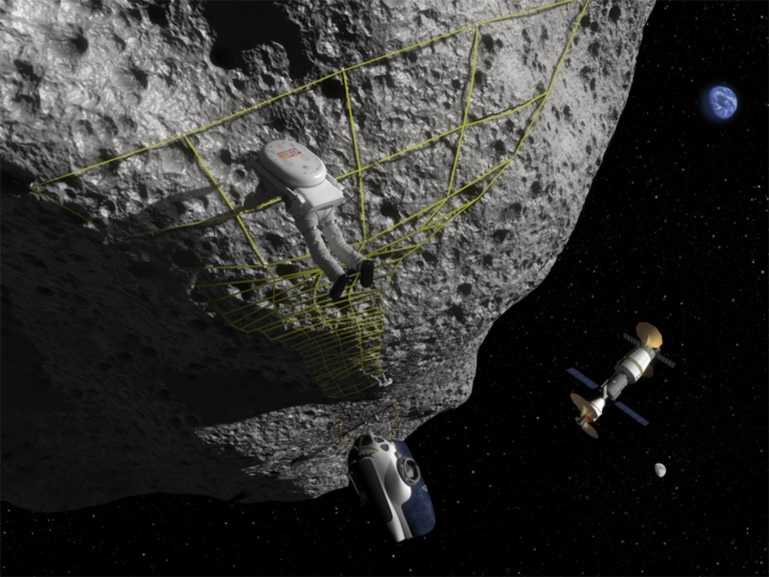Imagine plunking your spacecraft down on an asteroid. The gravity would be small. The surface would be uneven. The space rock might be noticeably spinning, complicating your maneuvering.
Humans have done it with robotic spacecraft before. The first time was in 2001, when NASA made a stunning landing with the NEAR Shoemaker spacecraft on Eros — using a craft that was not even designed to reach the surface. A new study, however, portrays getting close to these space rocks as perhaps even more hazardous than previously thought.
An experiment done aboard a “Vomit-Comet” like airplane, which simulates weightlessness, suggests that dust particles on comets and asteroids may be able to feel changes in their respective positions across far larger distances than on Earth.
“We see examples of force-chains everywhere. When you pick an orange from a pile in a supermarket, some come away easily, but others bring the whole lot crashing down. Those weight-bearing oranges are part of a force-chain in the pile,” stated Naomi Murdoch, a researcher at the Higher Institute of Aeronautics and Space (Institut Supérieur de l’Aéronautique et de l’Espace) in Toulouse, France.

“One important aspect of such chains is that they give a granular material a ‘memory’ of forces that they have been exposed to. Reversing the direction of a force can effectively break the chain, making the pile less stable.”
The Asteroid Experiment Parabolic Flight Experiment (AstEx) experiment was designed by Murdoch, Open University’s Ben Rozitis, and several collaborators from The Open University, the Côte d’Azur Observatory and the University of Maryland. It had a cylinder with glass beads inside of it, as well as a rotating drum at the heart.

In 2009, when they were postgraduate students, Murdoch and Rozitis took their contraption on board an Airbus A300, which flew parabolas to simulate microgravity while the aircraft falls from its greatest height.
During this time, the inner drum spun up for 10 seconds and then the rotational direction was reversed. What happened was tracked by high-speed cameras. Later, the researchers analyzed the movement of the beads with a particle-tracking program.
The researchers found that particles at the edge of the cylinder (the closest analog to low-gravity environments) moved more than those in similar environments on Earth. Those closer to the center, however, were not as greatly affected.
“A lander touching down on the surface on one side of a small, rubble-pile asteroid could perhaps cause an avalanche on the other side, by long-range transmission of forces through chains It would, however, depend on the angle and location of the impact, as well as the history of the surface – what kind of memories the regolith holds,” said Murdoch.
Check out more details of the experiment in the June 2013 issue of the Monthly Notices of the Royal Astronomical Society. It’s some interesting food for thought as NASA ponders an asteroid retrieval mission that so far has met with skeptical Congress representatives.
Source: Royal Astronomical Society


Mining asterods would be quite simple, if you had a glue manufacturing plant to tow around!
Just a vacuum cleaner to suck the asteroid up.
Couldn’t we just throw rocks at the asteroid to deliberately set off all the avalanches before we try to land?
This seems to me, vaguely interesting at best. Asteroids have all been hit by fellow space wanderers and thus are approximately in a state of equilibrium, having been jostled enough to produce any major effects. To say “avalanche” is to equate walking down a sand dune to a major catastrophe. Yes, some particles will slip but that’s why you take a shovel and leaf blower. (:
An avalanche at some 0.001 g? That’s stretching the definition a little bit. Any rocks moving fast enough to hurt you are probably at escape velocity already.
‘Asteroid Experiment Parabolic Flight Experiment experiment’
“S.(ervice) I.(ndusttry) N.(ight) Night” ALWAYS bugged the bejeebus out of me. But in this instance per the “Ex” in the acronym, the 1st (in that word-chain) “Experiment” is part of the actual name OF the experiment, so as it is written, it is the correct way of stating it. 😉
I’m sure the astronauts who go on the mission are more than willing to accept the risks. I know I would be.